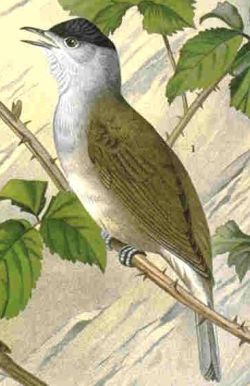Blackcap
|
|
| Blackcap | ||||||||||||||
|---|---|---|---|---|---|---|---|---|---|---|---|---|---|---|
| | ||||||||||||||
| Scientific classification | ||||||||||||||
| ||||||||||||||
| Binomial name | ||||||||||||||
| Sylvia atricapilla (Linnaeus, 1758) |
The Blackcap, Sylvia atricapilla, is a common and widespread Old World warbler which breeds throughout northern and temperate Europe.
This small passerine bird is migratory, and northern and central European breeders winter in southern Europe and north Africa, where the local populations are resident. It is hardier than most warblers, partly because it will readily eat small berries as well as the more typical warbler insect diet.
An interesting development in recent years is for substantial numbers of central European birds to winter in gardens in southern England. Presumably the ready availability of food, and the avoidance of migration over the Alps, compensates for the sub-optimal climate.
This is a bird of shady woodlands with ground cover for nesting. The nest is built in low shrub, and 3-6 eggs are laid.
This is a robust warbler, mainly grey in plumage. Although most warblers have the sexes identical, several Sylvia species have distinct male and female plumages. The male has a small black cap, which in the female is light brown.
The song is a pleasant chattering with some clearer notes like a Blackbird. The song can be confused with that of the Garden Warbler.da:Munk (Sylvia atricapilla) de:Mönchsgrasmücke lt:Juodagalvė devynbalsė nl:Zwartkop pl:Pokrzewka czarnołbista

